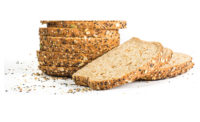The current plant-based protein trend is directly in line with public health findings, including recommendations to increase intake of nuts to improve overall diet quality. Nuts and seeds contribute dietary nutrition, as well as adding flavor, visual interest and texture to snacks and baked goods.
“Each nut and seed is a nutritional bomb, rich in flavor, that adds a textural twist to snacks and bakery products,” says Fatma Akalin-McGee, marketing and business development director, Petrow Food Group, Haverhill, England. “Although consumers buy snacks as an indulgence, the growing desire for health and wellness is as much a driving force as taste and convenience, creating an unstoppable momentum for seeds and nuts.”
Trending forward
Why are we seeing more interest in nuts and seeds? “The consumer wants all-natural, plant-based proteins from foods they know and understand,” says Bruce Kotz, vice president of specialty products, Golden Peanut and Tree Nut, Alpharetta, GA. “Today’s consumer does not want empty calories from snack foods—they are seeking protein for satiety and nutrition.”
Akalin-McGee says walnuts are “bursting with heart-friendly omega-3 fatty acid alpha-linoleic acid (ALA) and have enough fat to give a lush, rich taste.” Almonds are rich in vitamins and minerals and are rich in monounsaturated fatty acids.
An increasingly popular seed is the chia. Heartland Chia, Franklin, KY, is a farmer-owned company that holds the only license to grow chia in the U.S. Chris Kummer, president, says that chia is really a superfood. He pointed to a recent Mayo Clinic report that noted chia seeds are high in omega-3 fatty acids, are loaded with antioxidants and are high in many important bone nutrients. Plus, almost all of the carbohydrates in chia seeds are fiber, which helps stabilize blood sugar levels.
Chia has grown popular as an ingredient in tortilla chips, crackers, bars and even cookies. Kummer notes that chia seeds have binding properties, and that chia can partially replace sugar, salt and egg when used in baking. “It has no noticeable flavor, so it does not alter taste profiles,” he says.
Another seed that has grown popular among consumers is flaxseed. Tara Froemming, marketing coordinator, Healthy Food Ingredients, Fargo, ND, says that the “simply made” and “less processed” trend is growing in snacks, and that nuts and seeds fit well with this approach toward product development.
“Manufacturers are raising the bar to meet market demand with less-processed products using better-for-you ingredients such as ancient grains, plant-based proteins and ingredients that are value-added,” says Froemming. “As we look at flaxseed, it is often utilized in a less-processed, raw format.” She notes that raw flaxseed is a popular choice for use as a topping and in snacks, crackers and granola bars—and that use of raw flaxseed in products that don’t have a kill step can be a safe choice. “Our company has developed an innovative solution, Integri-Pure, for micro reduction, to provide that food-safety assurance,” she says.
Flour demand
Propelled by the demand for gluten-free products, nut flours have become a popular alternative to traditional flours. According to Jeff Smith, director of marketing, Blue Diamond Almonds Global Ingredient Division, Sacramento, CA, research indicates that gluten-free baking is projected to grow 44 percent between 2014 and 2018. “This and other proof indicates how strongly consumers have embraced gluten-free alternatives and how promising this category will continue to be.”
Because of the collaboration between consumer research and technical development, Smith believes that Blue Diamond can better direct manufacturers to the appropriate almond forms, including almond flour. “Almond flour is in high demand as an ingredient for baked goods,” he says, “and Blue Diamond’s almond flour has an amazingly smooth texture, unlike many gluten-free flours that tend to be gritty and rough. Bakers and snack manufacturers can easily transition from traditional to almond flour without compromising taste or texture.”
Blue Diamond’s almond flour has the same nutrition as whole almonds: Every ¼-cup serving contains 6 grams of protein, 3.5 grams of fiber and 75 milligrams of calcium. It is also a source of antioxidant vitamin E and healthy monounsaturated fat.
Wheat flour can also benefit from strategic combination with nut and seed flours. Brolite offers blends of wheat and seed flours, including Twelve Grains, a specialty blend of coarse grains, seeds and flakes for use in multigrain bagels, breads, buns and pizza crusts. Its Seeds-N-Grain product is a 50/50 base for coarse-textured, European-style, multigrain breads, buns and rolls.
Better with butters
If it seems like everywhere you go you see Nutella, you’re not alone. According to a report by The Food Institute, Ferrero Inc. grew Nutella from a $20 million brand to $320 million brand in just a decade.
Before Ferrero took the nut butter market by storm, nut butters were probably mostly associated with peanut butter and jelly sandwiches. Ferrero made us think about nut butters in a more- expansive way, opening the door for multiple usage occasions.
Trader Joe’s Speculoos Cookie Butter has also broadened the playing field. The product stands on its own, competing with other sweet nut butter spreads, but also forms the basis of the filling for its Cookie Butter Sandwich Cookies. It has also gone into a Cookie Butter Cheesecake and Cookie Butter Cheesecake Bites.
Now nuts like almonds and sunflower seeds are helping grow the nut butter ingredient segment. The popularity of almonds makes almond butter a natural fit for expansion into multiple applications.
According to Molly Spence, Almond Board of California, Modesto, CA, almond butter is now being used in a wide variety of applications such as fillings for bars, muffins and cookies, and as a topping on sweet breads, pastries and bars. “Almond butter is enticingly creamy and matches with all kinds of flavors, including globally inspired ingredients such as matcha, and sweet and savory flavors like chile and chocolate,” she says. “Due to the nutritional power of almonds, including them in new product formulations also means they can appeal to consumer demand for snack and bakery products that are healthy.”
The good news is that the versatility of nut and seed ingredients makes them easy to incorporate into a wide range of snack and bakery applications. As shoppers continue strive to improve their diet quality, nuts and seeds can play a powerfully important role.








